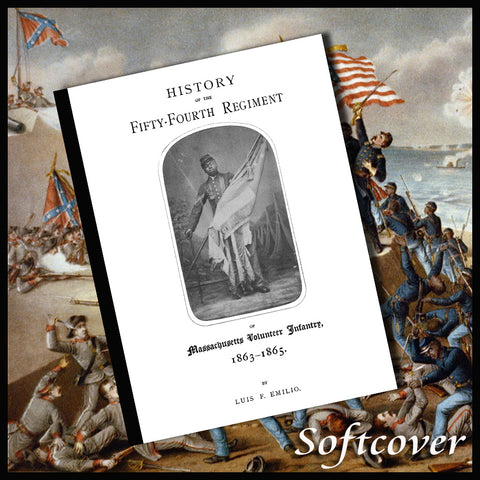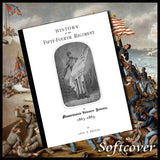54th Infantry MA - History of the Fifty-fourth Regiment of Massachusetts Volunteer Infantry, 1863-1865. "A Brave Black Regiment".
By Luis F. Emilio. 428p. illustrated. index. (1891)
CWMA54IH
The 54th Regiment Massachusetts Volunteer Infantry was the first African-American regiment organized in the northern states during the Civil War.
African-Americans were not allowed to serve as soldiers in the Union Army until January 1, 1863. On that day the Emancipation Proclamation decreed that “such persons [that is, African-American men] of suitable condition, will be received into the armed services of the United States.”
Early in February 1863, the abolitionist Governor John A. Andrew of Massachusetts issued the Civil War’s first call for black soldiers. Massachusetts did not have many African-American residents, but by the time 54th Infantry regiment headed off to training camp two weeks later more than 1,000 men had volunteered. Many came from other states, such as New York, Indiana and Ohio; some even came from Canada. One-quarter of the volunteers came from slave states and the Caribbean. Fathers and sons (some as young as 16) enlisted together. The most famous enlistees were Charles and Lewis Douglass, two sons of the abolitionist Frederick Douglass.
During its service with the X Corps, the 54th Massachusetts took part in the Second Battle of Fort Wagner on July 18, 1863. During this engagement, the 54th Massachusetts, with other Union regiments, executed a frontal assault against Fort Wagner and suffered casualties of 20 killed, 125 wounded, and 102 missing (primarily presumed dead)--roughly 40 percent of the unit's numbers at that time.
The 54th may have lost the battle at Fort Wagner, but they did a great deal of damage there. Confederate troops abandoned the fort soon afterward. For the next two years, the regiment participated in a series of successful siege operations in South Carolina, Georgia and Florida. The 54th Massachusetts returned to Boston in September 1865.
On Memorial Day 1897, the sculptor Augustus Saint-Gaudens unveiled a memorial to the 54th Massachusetts at the same spot on the Boston Common where the regiment had begun its march to war 34 years before. The statue, a three-dimensional bronze frieze, depicts Robert Gould Shaw and the men of the 54th as they marched heroically off to war. Above them floats an angel holding an olive branch, a symbol of peace, and a bouquet of poppies, a symbol of remembrance. The Shaw Memorial still stands today.



